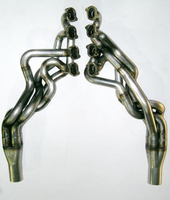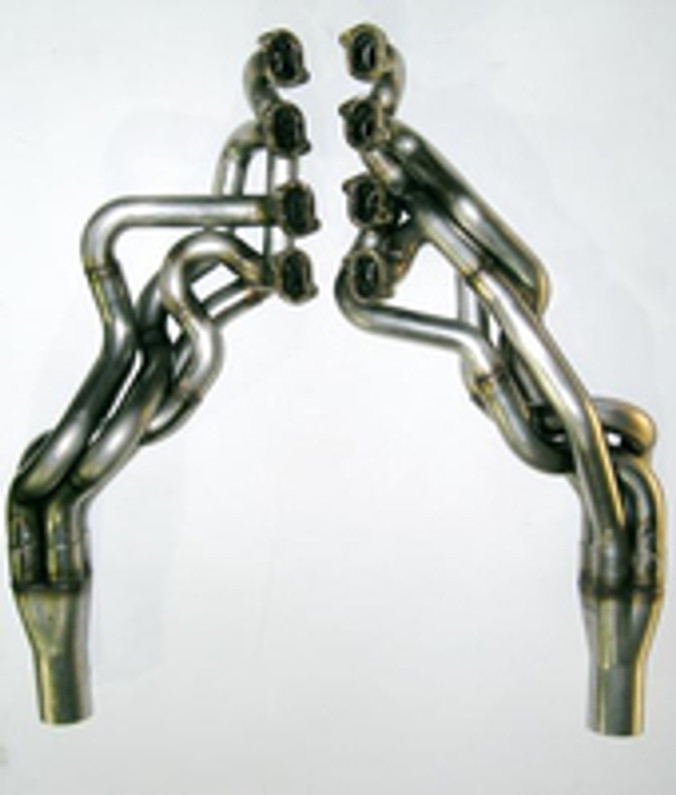How to Choose the Best Exhaust System for Your Mustang

Between the exhaust ports to the bumper, there are a lot of parts that make up your Mustang's exhaust. To get the best performance, each piece has to be taken into consideration.
When Bigger Isn't Better
When someone mentions exhaust modifications, the first word that comes to mind is
usually "backpressure." However, the word that should come to mind is "velocity." Simply put, higher velocity means more power.
If the exhaust is too open, there won't be enough force to push the exhaust gases out of the tailpipe. If it's too restrictive, the pistons will have to exert more force to push the gases through the system. The right size system will flow freely enough that the energy from the exhaust stroke will push the gases through the system. The more open the exhaust is, the more suited it will be to large volumes of gases expelled at high RPM at the expense of smaller volumes at low RPM.
The right size system doesn't just help with the exhaust; it also helps with the intake. During the exhaust stroke, there's a period where both the exhaust and intake valves are open. As the spent gases leave the combustion chamber, they pull in fresh air and fuel. Velocity is important for getting the optimum amount of scavenging.
That means you aren't sacrificing anything if you want an exhaust with catalytic converters to keep emissions under control and mufflers to keep sound to a sane level, so long as the components are the right fit for your engine. It also means putting the biggest system in you can find can actually cause your car to lose power.
Headers
Older cars use cast iron log manifolds to transfer gases from the exhaust ports of the head to a single opening. All that metal absorbs heat from the exhaust, and in turn warms up the engine bay. Since the inside is a straight tube, exhaust from the ports at the front have a longer distance to go, increasing backpressure for those cylinders.
A header uses individual pipes to transfer those gases to an opening. Each pipe is an equal length, so the backpressure is equal on each cylinder. By keeping everything balanced, the engine can run smoother and produce more power. Gasket and fastener improvements make headers reliable enough to be used on factory vehicles, as they are with the current Coyote V8.
Midpipes
Catalytic converters use a catalyst that reacts with the unburnt fuel in the exhaust, burning it off to reduce emissions. These need hot exhaust gas to work, so they're placed close to the engine. Improvements in design over the years have made these devices lighter, cheaper, and better flowing, letting your car stay emissions legal without sacrificing power.
Why does almost every V8 performance exhaust come with an X pipe? Exhaust leaves the engine in pulses as each cylinder pushes the spent gases through the exhaust valves. By connecting the exhaust of both cylinder banks, there are more of these pulses to push the exhaust gas along, resulting in smoother flow.
Cat Back Exhaust
These systems cover everything between the catalytic converters and the bumper including pipes, mufflers and tips. Catalytic converters muffle the exhaust a little, but most sound control is done by the mufflers. Reducing the baffles inside the muffler decreases restriction and increases noise. Some designs replace the baffles with an insulated chamber to deaden noise.
Getting the Right Fit
There are a lot of variables at play to find the right system for your car. That's why Anderson Ford Motorsport carries a wide range of exhaust systems from pipes designed for stock engines to big off-road systems. We can help you find the right setup whether you just want to add some rumble to your car's exhaust note or you need something to handle an extreme build.
Recent Posts
-
Bringing the Fox Body Mustang into the 21st Century with Holley Terminator X
Anderson Ford Motorsport has been in the Fox Mustang performance industry since 1989. One of the bi …22nd Oct 2021 -
Roush Supercharger install on a 2019 Ford Mustang
Check out this 2019 Ford Mustang before and after we installed a Roush Supercharger. …21st Feb 2020 -
All Blower Installations are not Equal.
Why Should You Choose a Company to Install Your Blower That Has a Dyno Facility In-House?Are all de …24th Jan 2020


